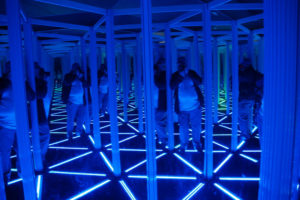
Photo © Mike Pennington (cc-by-sa/2.0)
The Pair
Our pair’s outcomes in the Remote Teacher Resources website addresses the immediate need of teachers: the ability to generate class content that assists and encourages learning and the ability to curate (select, organize and exhibit) online class resources to foster independent learning and accommodate learner differences and needs. Included in these abilities were the need to identify appropriate technologies, to predict difficulties students would have accessing the technology as well as the content and address these concerns, to construct interactive materials, to differentiate through the materials, and to design a variety of static and interactive tools for students to access both synchronously and asynchronously. A final aspect of the creation and curation of content was to be able to evaluate student learning.
Our resource activity included a large array of selected applications for a variety of methods of creating and curating content as well as suggestions on how to evaluate curated resources. Our posts directed readers to posts from other members of our cohort who focused on accessibility, communication between various stakeholders, and wellness. Included in our personal posts were examples of both created and curated content for students: a two-day lesson plan of created and curated resources, two curated resource pages, and a description of how those resources were evaluated. These examples are evidence of achieving the goal of having generated good class content and curated resources, and the reader can compare their materials to these exemplars. The current site, generated in a short period of time, is still rough around the edges but has some great content.
The Cohort
A focus on Ted Aoki’s lived curriculum is part and parcel of our group’s created resource. We have not created a traditional curriculum document; we provide no position of power by stating what must be done. Our cohort is providing content which the student has a choice in how they will explore and how they will utilize the information inside their own practices, choosing as much or as little as they can manage to master. In our own way we have provided a resource where we are not requiring teachers to participate in a set way and order, but we are responding to a need of teachers responding to the pandemic’s teaching requirements. We are not face-to-face with the teachers, but our narrative will provide teachers with the opportunity to live in the moment between our curriculum-as-plan with its numerous outcomes, and the curriculum in which they will live (Aoki, 1993).
By creating this resource as a list of resources and then a created resource based on those resources, we have a significant hidden curriculum. Our unwritten, unofficial, lessons, values, and perspectives are about how teachers should interact with students, other teachers, and their students’ families. The ideas and behaviors that we consider acceptable are obvious from what is included on the site. The framework of the curriculum we have created is fluid, and our positions as teacher and students are interchangeable as we contributors can learn from the site, other teachers (our ‘students’) can learn and can also contribute through comments, interaction, and requests to have their posts linked. The role of teacher and student is re-visioned (Nahachewsky and Slomp, 2009) and this is probably the main point of our hidden curriculum; the teacher is not the ‘sage on the stage’ but is the facilitator.
The Community
We have stretched our digital resource further than the resources referenced in Nahachewsky and Slomp’s (2009) article, as our digital classroom has little formal interaction. Our site recognizes creating a community in the digital classroom is extremely important as is evidenced by the number of posts on community and communication. Through linking to other blogs and sites, we hope to raise the site’s level in search engines so a community can be established. I, for one, also plan to encourage use of this site with my International Baccalaureate colleagues. Our hope is that having comments allowed on the blog posts and enabling connections with Twitter will encourage some real community, but it will depend on how well the site is utilized.
For many Indigenous peoples, community is at the centre of interactions (Donald, 2009). Our site’s focus on community and communication is a hidden curriculum on ways to recognize Indigenous ways of knowing. Focusing on the community and building up each other rather than competition for the ‘highest grade’ or getting done first becomes more possible in the digital classroom where asynchronous work takes place and where student ability to monitor others’ progress is limited. Students are put into a situation to learn and seek ‘wisdom’ where they can – internet, books, each other, teacher . . . According to Donald (2009), one of the most important ways to foster ethical educational space is through work that requires human connectivity as a critical starting point.
As we are not a large group of people and our time for post creation is short, there are some missing elements from the entire website, including specific posts on how to include Indigenous content authentically, how to fully incorporate First Peoples Principles of Learning, how to encourage inquiry and how to address motivation and self-management, although there is some reference to most of these elements in the site. I am hoping more posts will be written to address the missing issues.
References
Aoki, T. T, (1993). Legitimating lived curriculum: Towards a curricular landscape of multiplicity, Journal of Curriculum and Supervision, 8(3). 255-268.
Donald, D. T. (2009). The curricular problem of Indigenousness: Colonial frontier logics, teacher resistances, and the acknowledgment of ethical space. In J. Nahachewsky & I. Johnston (Eds.), Beyond ‘presentism’: Re-imagining the historical, personal, and social places of curriculum (pp.23-41). Sense Publishers.
First Nations Education Steering Committee. (2015, September). First Peoples Principles of Learning. [Poster]. http://www.fnesc.ca/wp/wp-content/uploads/2015/09/PUB-LFP-POSTER-Principles-of-Learning-First-Peoples-poster-11×17.pdf
Nahachewsky, J. & Slomp, D. (2009) Sound and Fury: Studied response(s) of curriculum and classroom in digital times. In J. Nahachewsky & I. Johnston (Eds.), Beyond ‘presentism’: Re-imagining the historical, personal, and social places of curriculum (pp.139-151). Sense Publishers.



 Planning a wedding for my daughter and her partner and the limited Covid guest list was very different than the original plan for a larger guest list which would be very different from the wedding Joanna and her partner planned for June 30th as opposed to the wedding they had planned for April. Yet, no matter how much you plan and think ahead of possible alternatives, the reality will be slightly different. The same goes in the classroom. I have taught private music students as well as in schools for over thirty years and although some of the high school and middle school math, information processing, band, choir and Christian ethics (with a smattering of science and accounting thrown in) were the exact same courses, I cannot say they were presented the same or even covered the exact same concepts or learning objectives. You can plan and postulate, but when you get your ‘guests’ in front of you, the ‘atmosphere’ affects what can be accomplished. The context affects the presentation of the content. I found there was an equal amount of similarity between years of teaching the same course as there was between teaching the same year of students from Saskatchewan to British Columbia curriculum (which granted, was similar for mathematics and music but wildly out of date in a variety of ways for information processing/design courses). Even our well-planned wedding celebration changed significantly due to drizzling rain and the relaxed nature of our guests. We were able to incorporate some of the frame while making a consistent effort to remove and edit the parts of it that were not working for us, just the way you need to work a curriculum according to Blades.
Planning a wedding for my daughter and her partner and the limited Covid guest list was very different than the original plan for a larger guest list which would be very different from the wedding Joanna and her partner planned for June 30th as opposed to the wedding they had planned for April. Yet, no matter how much you plan and think ahead of possible alternatives, the reality will be slightly different. The same goes in the classroom. I have taught private music students as well as in schools for over thirty years and although some of the high school and middle school math, information processing, band, choir and Christian ethics (with a smattering of science and accounting thrown in) were the exact same courses, I cannot say they were presented the same or even covered the exact same concepts or learning objectives. You can plan and postulate, but when you get your ‘guests’ in front of you, the ‘atmosphere’ affects what can be accomplished. The context affects the presentation of the content. I found there was an equal amount of similarity between years of teaching the same course as there was between teaching the same year of students from Saskatchewan to British Columbia curriculum (which granted, was similar for mathematics and music but wildly out of date in a variety of ways for information processing/design courses). Even our well-planned wedding celebration changed significantly due to drizzling rain and the relaxed nature of our guests. We were able to incorporate some of the frame while making a consistent effort to remove and edit the parts of it that were not working for us, just the way you need to work a curriculum according to Blades.
Recent Comments